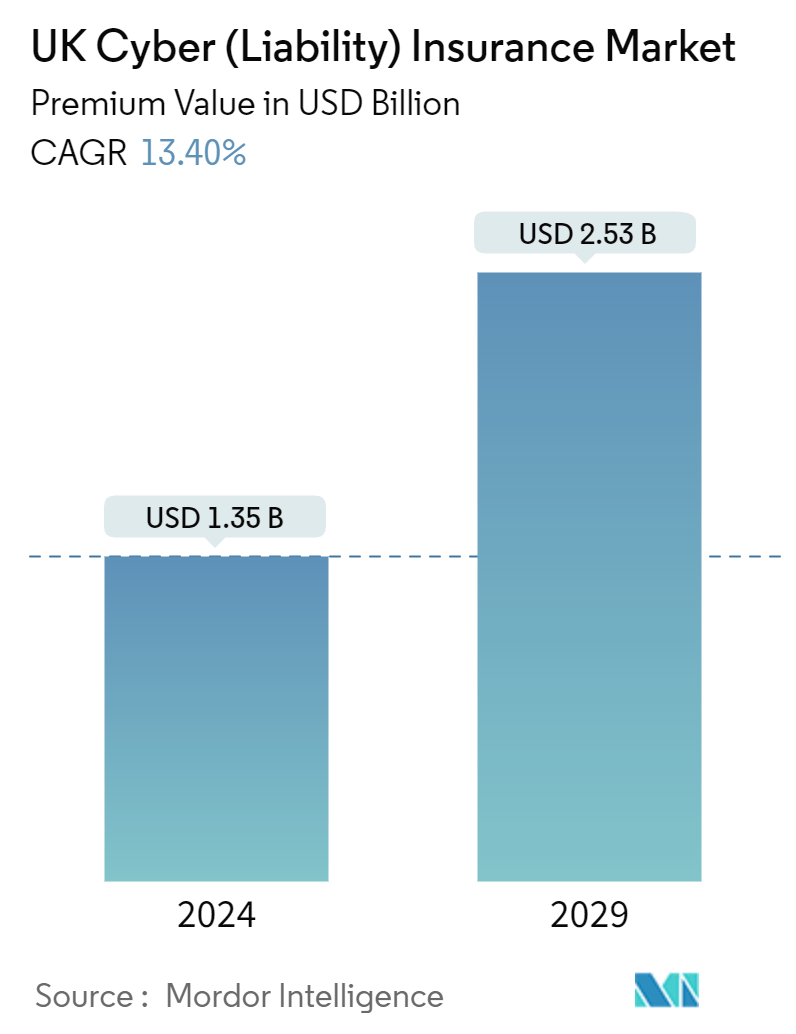Market Size of UK Cyber (Liability) Insurance Industry

| Study Period | 2020 - 2029 |
| Base Year For Estimation | 2023 |
| Market Size (2024) | USD 1.35 Billion |
| Market Size (2029) | USD 2.53 Billion |
| CAGR (2024 - 2029) | 13.40 % |
| Market Concentration | Medium |
Major Players
*Disclaimer: Major Players sorted in no particular order |
UK Cyber Insurance Market Analysis
The UK Cyber Insurance Market size in terms of premium value is expected to grow from USD 1.35 billion in 2024 to USD 2.53 billion by 2029, at a CAGR of 13.40% during the forecast period (2024-2029).
While the concept of insurance and its function of risk mitigation has remained the same over time, policies have had to adapt to stay relevant and accommodate the changing nature of risks. This includes insurance firms providing services throughout an insurance contract beyond solely paying out for claims as was traditionally the case. As a result of this evolution, several new forms of insurance have emerged—cyber insurance being one of them. Cyber risks have developed and gained increasing attention over the last 10−20 years, considering our increasing reliance on technology and connectivity. Cyber insurance caters to a spectrum of risks. At one end, there are higher-frequency, ‘daily life ’-type risks, such as data fraud, theft, or other privacy breaches. On the other end, there are ‘extreme scenario ’-type risks, such as NotPetya and Wannacry, which can result in severe disruption to many businesses. In the NotPetya attack, the virus froze the user’s computer and demanded a ransom to be paid. Businesses with strong trade links with Ukraine, such as the UK’s Reckitt Benckiser, Dutch delivery firm TNT, and Danish shipping giant Maersk, were affected. e WannaCry ransomware crypto-worm, which is estimated to have hit over 230,000 computers across at least 150 countries. The attack used a specific Microsoft Windows vulnerability to encrypt data and demand ransom payments. Among the range of sectors and industries hit, one of the largest agencies to suffer was the NHS, which was still largely reliant on outdated software and operating systems, making it vulnerable to attack.
Cyber insurance has and will continue to play an important role in the UK economy, both through the direct benefits to the UK business as well as the impact on the economy more broadly. Looking ahead, the cyber insurance market is expected to continue to undergo major development and rapid growth over the next few years, reflecting the increased awareness of risks as well as the likely increase in the frequency of cyber events driven by the broader trend of increasing digitization of businesses, which in part, were hastened by the COVID-19 pandemic. This poses challenges for data security as the quantity of data susceptible to cyber-crime increases. To tackle the challenges that arise from increasing connectivity, it is expected that coverage of cyber risks will continue to expand. To reflect this, the relevance and importance of cyber coverage in the overall functioning of the economy is expected to increase significantly.
The UK cyber insurers are adapting and improving their risk mitigation and containment processes (alongside UK cyber security firms). By sharing these techniques with businesses, UK cyber insurers can help to reduce the risks posed by cyber incidents. The complexity of cyber risks also means that reinsurance can play an important role in expanding the supply of cyber insurance.
UK Cyber Insurance Industry Segmentation
Cyber liability insurance is an insurance policy that provides businesses with a combination of coverage options to help protect the company from data breaches and other cyber security issues. It's not a question of if the organization will suffer a breach but when. Travelers and cyber insurance policyholders can also access tools and resources to manage and mitigate cyber risk. Cyber insurance generally covers your business's liability for a data breach involving sensitive customer information, such as Social Security numbers, credit card numbers, account numbers, driver's license numbers, and health records.
The UK cyber (liability) insurance market is segmented by product type (packages, standalone) and application type (banking & financial services, IT & telecom, healthcare, retail, and other application types).
The report offers market size and forecasts for the UK cyber (liability) insurance market in value (USD) for all the above segments.
| By Product Type | |
| Packaged | |
| Standalone |
| By Application Type | |
| Banking & Financial Services | |
| IT & Telecom | |
| Healthcare | |
| Retail | |
| Other Application Types |
UK Cyber (Liability) Insurance Market Size Summary
The UK cyber liability insurance market is experiencing significant growth, driven by the increasing reliance on technology and the rising frequency of cyber threats. As businesses become more digitized, particularly in the wake of the COVID-19 pandemic, the demand for cyber insurance has surged. This market evolution reflects the broader trend of adapting insurance policies to address the dynamic nature of cyber risks, which range from everyday data fraud to severe incidents like the NotPetya and WannaCry attacks. The market is characterized by a diverse array of players, including established insurance giants, specialized cyber insurers, and insurtech startups, all working to meet the growing demand for comprehensive cyber liability coverage. The competitive landscape is fostering innovation in policy design and risk assessment, ensuring that insurance offerings keep pace with the evolving threat landscape.
As the market expands, cyber insurers are enhancing their risk mitigation strategies and improving their understanding of individual business needs, allowing for more tailored coverage. This includes offering policies that require businesses to meet specific cybersecurity standards, thereby encouraging proactive security measures. Despite the benefits, challenges remain, such as coverage limits and deductibles that can impact financial burdens, and the potential reputational damage from breaches. The market is also seeing increased participation from reinsurers, which helps to broaden the availability of cyber insurance. Companies like Cowbell and Coalition are entering the UK market, offering customized policies and enhanced coverage options, further underscoring the market's growth potential and the critical role of cyber insurance in safeguarding businesses against cyber threats.
UK Cyber (Liability) Insurance Market Size - Table of Contents
-
1. MARKET INSIGHTS AND DYNAMICS
-
1.1 Market Overview
-
1.2 Market Drivers
-
1.2.1 Data Privacy Regulations
-
1.2.2 Business Interruption
-
-
1.3 Market Restraints
-
1.3.1 Complexity and Lack of Understanding
-
1.3.2 Cost of Coverage
-
-
1.4 Value Chain Analysis
-
1.5 Market Opportunities
-
1.6 Porter's Five Forces Analysis
-
1.6.1 Bargaining Power of Suppliers
-
1.6.2 Bargaining Power of Buyers/Consumers
-
1.6.3 Threat of New Entrants
-
1.6.4 Threat of Substitute Products
-
1.6.5 Intensity of Competitive Rivalry
-
-
1.7 Insights on Technological Innovations in the Market
-
1.8 Insights on Consumer Behavior Analysis
-
1.9 Government Regulation in Market
-
1.10 Impact of COVID-19 on the Market
-
-
2. MARKET SEGMENTATION
-
2.1 By Product Type
-
2.1.1 Packaged
-
2.1.2 Standalone
-
-
2.2 By Application Type
-
2.2.1 Banking & Financial Services
-
2.2.2 IT & Telecom
-
2.2.3 Healthcare
-
2.2.4 Retail
-
2.2.5 Other Application Types
-
-
UK Cyber (Liability) Insurance Market Size FAQs
How big is the UK Cyber Insurance Market?
The UK Cyber Insurance Market size is expected to reach USD 1.35 billion in 2024 and grow at a CAGR of 13.40% to reach USD 2.53 billion by 2029.
What is the current UK Cyber Insurance Market size?
In 2024, the UK Cyber Insurance Market size is expected to reach USD 1.35 billion.

